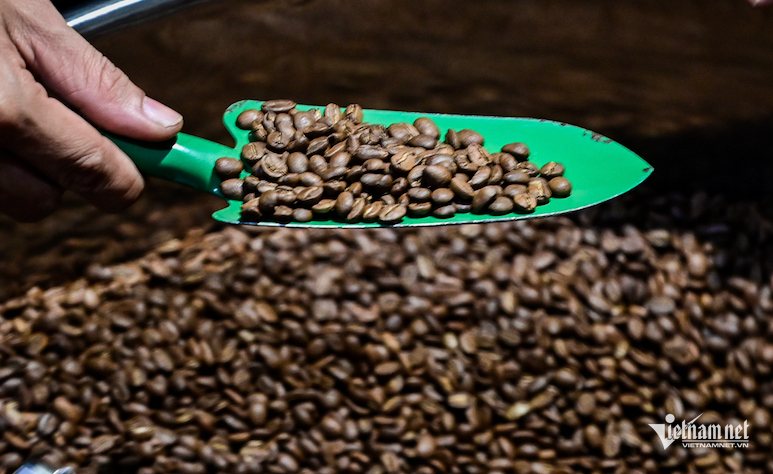
According to the latest report from the Ministry of Agriculture and Rural Development, Vietnam’s total agricultural, forestry, and fishery export revenue in January 2025 reached $5.08 billion, a 4.9% decline compared to the same period in 2024.
Many key agricultural exports, including fruits, rice, cashews, and timber, recorded negative growth.
However, coffee exports defied this trend, achieving unprecedented figures.
Vietnam exported only 140,000 tons of coffee in January 2025, marking a sharp 41.1% drop in volume compared to the same period last year. Yet, the total export value rose by 5% to $763 million, the highest monthly revenue ever recorded.
This remarkable performance was driven by a significant surge in coffee prices. The average export price of Vietnamese coffee in January was estimated at $5,450 per ton, up 78.5% from the previous year.
Notably, with its $763 million revenue in January, coffee surpassed fruit exports ($400 million) and seafood exports ($750 million), becoming Vietnam’s second-largest agricultural export, trailing only timber and wood products ($1.4 billion).
Record prices boost coffee exports
In 2024, Vietnam exported 1.3 million tons of coffee, generating $5.62 billion in revenue. While export volume declined by 17.1% compared to 2023, total value soared by 32.5%.
The average export price of Vietnamese coffee in 2024 reached $4,178 per ton, reflecting a 59.9% increase from the previous year.
Germany, Italy, and Spain were the three largest markets for Vietnamese coffee in 2024, accounting for 10.7%, 8.2%, and 7.9% of total exports, respectively. Among Vietnam’s 15 key export markets, Malaysia recorded the highest growth, with coffee exports doubling. The Netherlands followed with a 94% increase, while exports to Belgium saw the smallest increase at 9.3%.
Vietnam is the world's top supplier of robusta coffee, which accounts for 90% of the country's coffee-growing area.
According to Taste Atlas, a renowned global food ranking site, Vietnamese robusta coffee has a distinctive caramelized, slightly bitter flavor when roasted.
When paired with condensed milk, it creates a perfectly balanced taste. In contrast, arabica coffee has a more acidic profile that does not blend as smoothly with milk.
During the Lunar New Year holiday, supply disruptions from Vietnam contributed to a sharp rise in global robusta prices, setting a record of $5,609 per ton on January 31 (the second day of the Lunar New Year).
Coffee prices continue to climb, expected to reach new highs
On February 6, robusta coffee prices on the London exchange continued their upward trend, reaching $5,643 per ton for March 2025 contracts and $5,646 per ton for May 2025 contracts.
Domestically, coffee bean prices have climbed to between VND 129,000 and 130,000 ($5.10–$5.14) per kilogram, approaching the peak of VND 131,000 ($5.18) recorded in mid-2024.
With current market conditions, some analysts predict that coffee prices could soon reach VND 150,000 ($5.93) per kilogram or even higher. Historically, coffee prices tend to decline during the peak harvest season (November to January) before rising again as global buyers become more reliant on Vietnamese supply.
Outlook for Vietnam’s coffee industry in 2025
Speaking with VietNamNet, Nguyen Thanh Thuy, CEO of Golden Beans Coffee (SHIN Coffee), stated that the global and Vietnamese coffee markets in 2025 will be dynamic and may see unexpected shifts.
She emphasized that climate change remains a pressing issue, particularly for coffee-growing regions in Brazil and Vietnam - the world’s two largest coffee producers. Adverse weather conditions are already making coffee cultivation more challenging and further tightening global supply.
In 2025, Vietnam’s coffee exports are projected to increase by 1.8 million bags, reaching 24.4 million bags. However, Thuy warned that businesses will face challenges in maintaining high-quality raw materials. While rising coffee prices bring economic benefits, they do not necessarily guarantee improved quality.
In 2024, despite record-breaking export revenues, many Vietnamese coffee exporters struggled due to fierce price competition and supply chain disruptions.
Nonetheless, Thuy remains optimistic about the industry’s future. She noted that coffee consumption in major global markets continues to rise, providing strong growth opportunities for Vietnam’s exports.
However, factors such as climate conditions, supply-demand imbalances, and geopolitical developments will play a decisive role in shaping the market.
Businesses must be prepared to navigate both risks and opportunities in the evolving global coffee trade.
Tam An